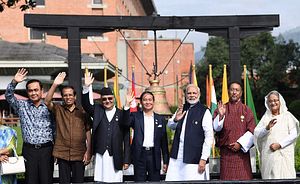The Bay of Bengal Initiative for Multi-Sectoral Technical and Economic Cooperation (BIMSTEC) held its first-ever military exercise in September 2018 in Pune, India. Termed “MILEX-2018,” the transnational exercise aimed to boost interoperability among forces and exchange best practices in counterterrorism. This exercise came just a fortnight after the fourth BIMSTEC Summit was held in Kathmandu on August 30-31. The summit saw the signing of a Memorandum of Understanding (MoU) on establishing a BIMSTEC Grid Interconnection to enhance energy cooperation among the seven BIMSTEC member states — Bangladesh, Bhutan, India, Myanmar, Nepal, Sri Lanka, and Thailand.
Keeping the momentum going, a connectivity meeting in Thailand came soon after the military exercise. Senior officials met to discuss the BIMSTEC Transport Connectivity Master Plan, which is to be finalized this year. The $50 billion project would have 167 connectivity-related components.
This flurry of activity is unusual for the subregional grouping, which has had very little visibility even within the region in the last two decades. Established in 1997, BIMSTEC planned to hold summits every two years, ministerial meetings every year, and senior officials’ meetings twice a year. However, the last two decades only saw three summits. No ministerial meeting was held between 2014 and 2017, and the senior officials’ meeting was postponed seven times during 2014-17.
Why the Renewed Interest?
Changing geopolitical realities in the region have brought about a renewed interest in the Bay of Bengal. As the regional grouping of choice in South Asia — the South Asian Association for Regional Cooperation (SAARC) — flounders with strained India-Pakistan relations, New Delhi has realized that BIMSTEC will allow for a broader playing field. Strategically located in the Indian Ocean, the Bay of Bengal and BIMSTEC not only cater to the wider concept of “Indo-Pacific” and an Indian Ocean community that New Delhi espouses, it also includes two ASEAN member states (Myanmar and Thailand) in its ranks, which is crucial for New Delhi’s key foreign policy priorities, the Act East Policy and Neighborhood First. Both these policies aim for connectivity and development in the frontier states of India’s northeast and tackle the issue of cross-border insurgency that has plagued this region for decades. With the northeast sharing borders with four BIMSTEC countries, including Myanmar, the possibility of multiregional cooperation with Southeast Asia and ASEAN makes it an attractive alternative to SAARC.
Another major catalyst for the renewed interest is the rise of China, which has completely changed the strategic geography and regional security architecture in recent years. The Bay of Bengal as an access route to the Indian Ocean is crucial for Beijing. As such, China has undertaken the Belt and Road Initiative (BRI) to promote infrastructure development across South and Southeast Asia. China’s trillion-dollar project and increasing footprint in the Indian Ocean have shaped present day domestic politics and foreign policy of countries in the neighborhood and beyond, including the Bay of Bengal littorals.
As Sri Lanka assumes current chairmanship of BIMSTEC, successfully leading the subregional grouping is vital for Colombo to prove its ability to play a larger role in Indian Ocean initiatives.
For Bangladesh, BIMSTEC is a platform for much needed economic development through regional integration. Although the Rohingya issue was not brought up at the summit, the forum does provide an opportunity on the sidelines for Dhaka and Naypyidaw to address outstanding issues if they wish to do so.
The landlocked Himalayan nations of Nepal and Bhutan see BIMSTEC as a way to further integrate with the Bay of Bengal region. For Myanmar and Thailand, which are also part of ASEAN, BIMSTEC allows for a way to address overdependence on China and balance Beijing by providing access to consumer markets in India and other rising BIMSTEC economies.
What Next for BIMSTEC?
BIMSTEC failed to generate interest and visibility even within the region in the last 20 years. Now that the subregional grouping has finally managed to gain momentum, it is crucial for BIMSTEC to seize the moment and show tangible results on the ground.
To start with, BIMSTEC would be wise if it narrowed down its areas of focus from 14 to six — trade and investment, connectivity, energy, people-to-people exchanges, counterterrorism, and the Blue Economy — and enhanced the institutional capacity of its Secretariat.
Additionally, the BIMSTEC region requires a Free Trade Agreement (FTA), no matter how limited in scope. Even with its members boasting a combined GDP of $2.8 trillion, intraregional trade in BIMSTEC barely exceeds 5 percent of the total, compared to 30 percent within ASEAN. Negotiations for a BIMSTEC FTA have been dragging on for the last 14 years.
To facilitate an FTA, connectivity should be of priority. The Bay of Bengal is one of the least integrated regions in the world, despite being home to 1.6 billion people, or nearly 23 percent of the world’s population. A Thailand-initiated scheme to “Connect the Connectivities” under the pending BIMSTEC Coastal Shipping Agreement aims to connect BIMSTEC members through a network of ports running from Thailand, Bangladesh, India’s Kolkata, Chennai, and Visakhapatnam, and Sri Lanka.
Though BIMSTEC has several connectivity projects in the pipelines, slow movement on the ground is a reason why the subregional grouping has been largely rendered ineffective until now. BIMSTEC should prioritize finishing up the India-Myanmar-Thailand Trilateral Highway and the Kaladan Multimodal Transit Transport Project, which will allow for sea-access for India’s landlocked northeastern states via the Kaladan river in Myanmar. Both projects have lagged behind deadlines for years.
With access to the Indian Ocean and the Himalayas, BIMSTEC is becoming the theater of convergence and competition for China’s Belt and Road Initiative, India’s Act East policy, and the Asia-Africa Growth Corridor. It remains to be seen if BIMSTEC can seize the day and utilize the momentum to remodel itself as a grouping to be reckoned with.
Nazia Hussain is a Research Analyst at the S. Rajaratnam School of International Studies (RSIS), Nanyang Technological University, Singapore.

































